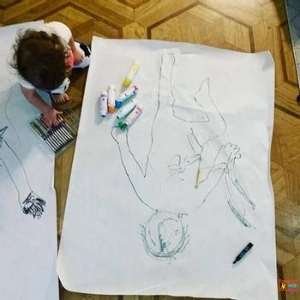
In an overseas visit to my family, I noticed that my aunt had life size portraits of her grandchildren hanging in her bedroom. I loved how each child decorated their own portrait differently, with no influence from an adult.
In an effort to unite my children with their cousins around the world, I ordered some butcher paper and make our own as an invitation to create for my children while also discussing a delicate topic (skin color) in a way that makes sense to young kids.
*As an Amazon Affiliate I may get a small commission from purchases made through my links at no extra cost to you. It's probably 2 cents, but hey, a penny saved is a penny earned.

We used People Colors from Lakeshore Learning to find the matching skin tone for each kiddo as we drew. Snag your own "People Colors" set from Lakeshore here. (I'm not their affiliate but I LOVE these)
Update in 2021: Crayola now makes people colors and they're called Multicultural Crayons!


Using multicultural crayons is a very natural way to discuss diversity, particularly skin color, with young children. When we first got ours, we read out the names of all the colors in the box: coral, sable, chestnut, maize, peach, ebony, mocha, melon.
We talked about how all the colors of skin are beautiful and important, including the ones we chose for ourselves. Positive Self Talk can improve kids confidence, so don't be afraid to compliment you're own looks and what makes you special. (Here is a great positive self talk activity you can print out for free).
We also discussed that the words "black" and "white" are opposites, but that people really come in all shades of the same color, not opposites at all. When we stop feeling like we are opposite, then we can focus on what we have in common.
We all have hearts; all of us feel joy and sadness; we all like to be a part of a community, to feel like we belong.

Children do notice differences between people, so rather than "shush" them or pretend they don't exist, when a child notices something different about another, we can acknowledge that difference and validate that being different is what makes us special and interesting.
When we bring up the subject of race with kids from an early age, we can teach respect, love, and unity before they reach an age where they feel uncomfortable discussing race or worse, when society has taught them negative stereotypes and biases that will need to be unlearned.
We are all human, and we are all beautiful. It's never too early to teach our children to appreciate the beauty of every color and the people behind the colors as well.
Social emotional learning refers to learning about ourselves and how we fit in with others. By discussing positivity in differences, we are allowing children to ask questions and face biases that they may have already learned.
The Collaborative for Academic, Social, and Emotional Learning (CASEL) lists 5 core competencies:
1. Self-Awareness
2. Social Awareness
3. Responsible Decision-Making
4. Self-Management
5. Relationship Skills
By first discussing our own self as we create life sized portraits, we build children's self-awareness. By discussing the differences between portraits and also the differences among all people we are helping build children's social awareness and relationship skills.